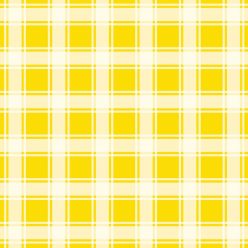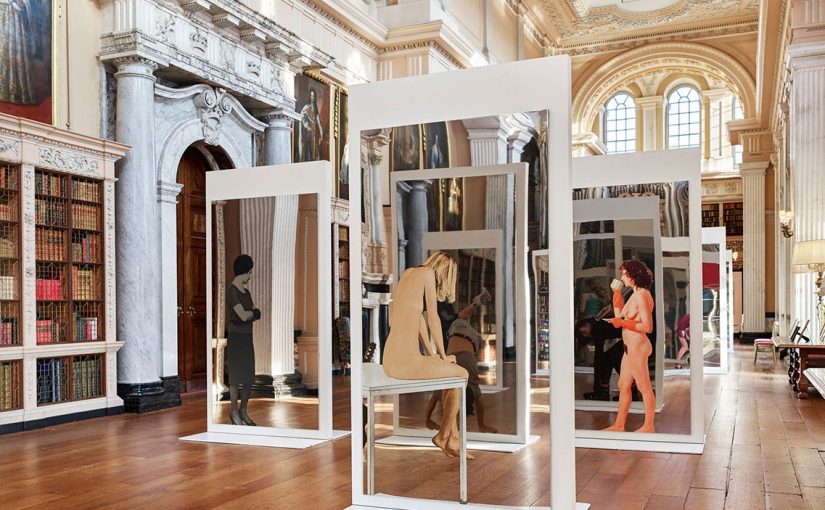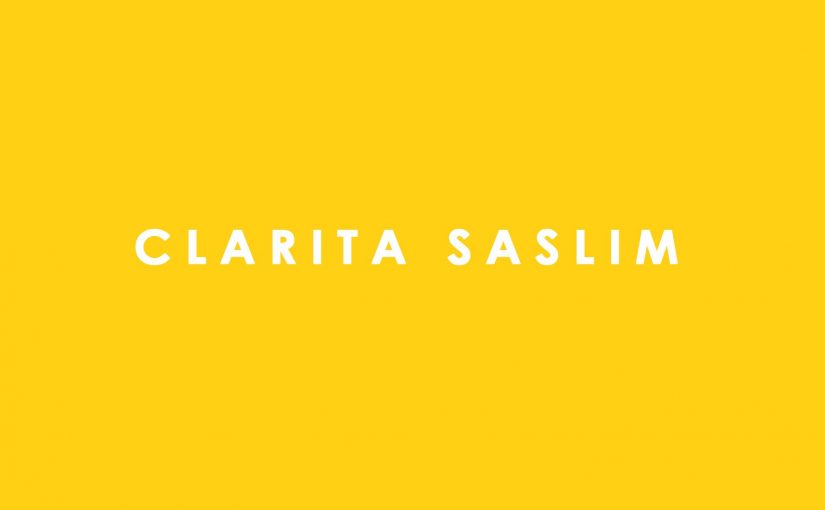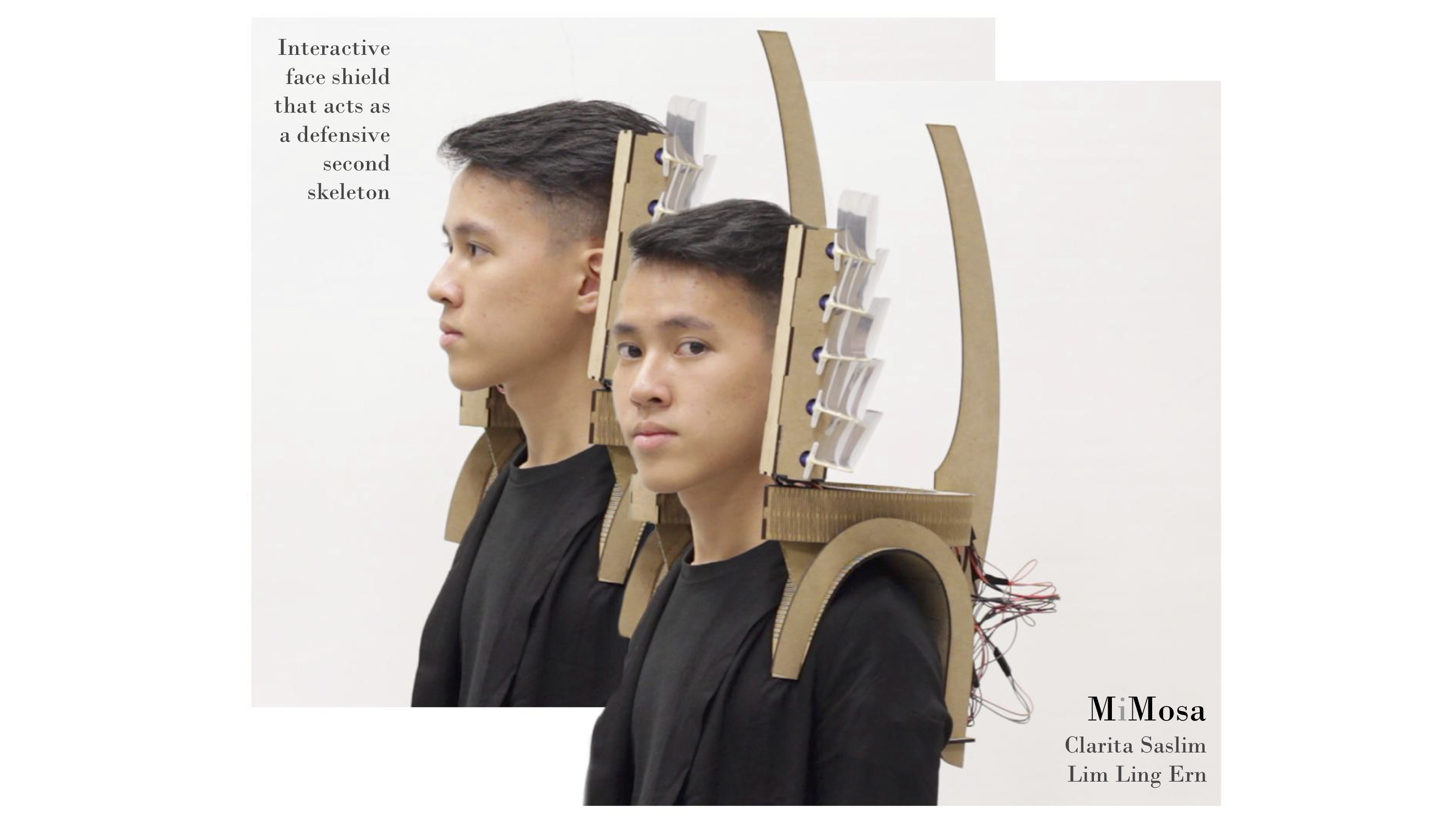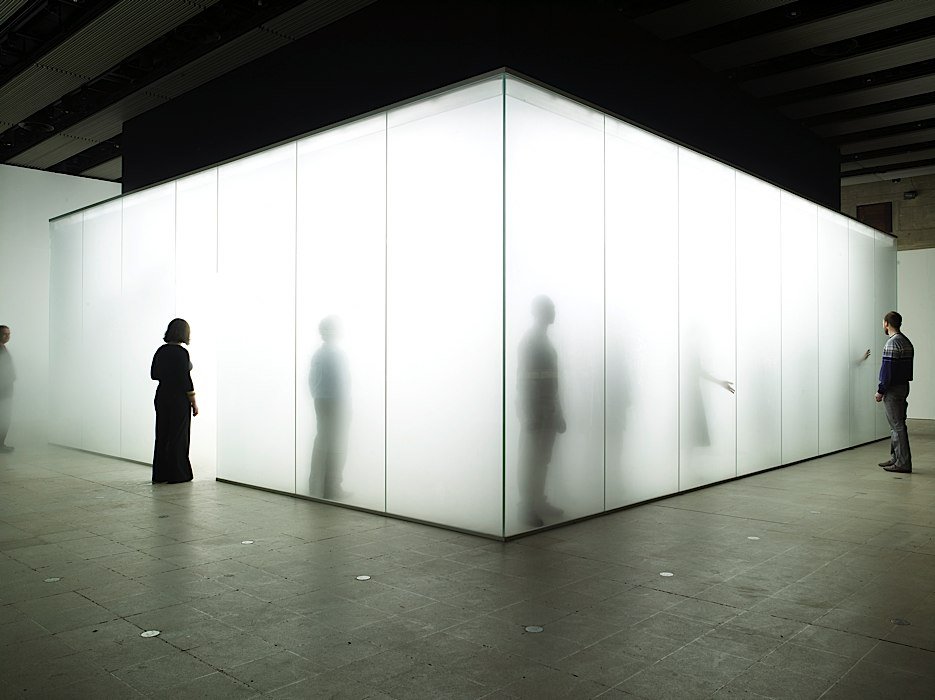Category: Project Management & Planning
100 Words – FYP
“ H o m e i s w h e r e t h e h e a r t i s ”
This expression dispels the idea that a home is bound to a specific place or geographical location. To me, it is a reminder that grounds me when I start to live as if the earth is mine alone. I have always sought to find my place in the world, and my experiences play a huge part in this search for my identity. How can we find home if we can’t find ourselves? In my FYP, I seek to explore the meaning of home, and maybe along the way, I will find myself too.
Minimalism Show – Olafur Eliasson and His Room For One Colour
O L A F U R E L I A S S O N

Olafur Eliasson isn’t an unfamiliar name to me. I have previously been accustomed to his works, even though to be honest I don’t remember which work exactly was first. But one that stood out is The Weather Project, which was done way back in 2003.

Created for the Turbine Hall of Tate Modern, London, this site-specific installation employed a semi-circular screen, a ceiling of mirrors, and artificial mist to create the illusion of a sun. Aluminium frames lined with mirror foil were suspended from the ceiling to create a giant mirror that visually doubled the volume of the hall – along with the semi-circular screen mounted on the far wall, its long edge abutting the mirror ceiling. Backlit by approximately 200 mono-frequency lights, the semi-circle and its reflection created the image of a massive, indoor sunset seen through the artificial mist emitted into the room. By walking to the far end of the hall, visitors could see how the sun was constructed, and the reverse of the mirror structure was visible from the top floor of the museum.
I loved this work, how simple yet so impactful it was. I loved how it completely transformed the space, I loved the grandness of it, the size of it. The atmosphere it created, and the environment it created. The way it influenced how people interacted with it, with each other.


People lied down on the floor, watching themselves in the mirror above them. It was interesting how at some parts the audience created something for themselves as seen above. An interaction that would not have existed if it weren’t for this installation.
Olafur Eliasson is well known for his large scale sculptures and installations. He often includes elemental materials such as light, water, and air temperature to engage with the viewer’s perception of space.
In this video, Eliasson talks about the formation of an idea, and likens the space ideas comes from to a treasure room. He talks about how sometimes words can amplify an idea, but sometimes, letting intuition flow in, the idea can be delivered more productively.
As someone who overthinks and is indecisive, I tend to put a lot of words into my work, feeling the need to justify everything so that everyone can understand me and my work, and it is difficult for me to be concise.
The video opened up my thoughts about how ideas can be delivered. The body reacts instinctively, and through understanding it and its host – humans, we can understand the essence of interaction better.
M I N I M A L I S M S H O W
The Minimalism Show was very enjoyable. There were so many works, and it was intriguing to see so many ways a minimalistic approach was interpreted, by the artists, and then the audience. It was hard to choose a favorite, since I was really captivated by many. However, Eliasson’s Room For One Colour was one that solicited an immediate memorable response from me.
I think it’s fun to explore the museum with no expectations of what works I would be discovering. The element of surprise changes the experience completely.

Upon entering the space, you immediately notice that your sense of vision has been altered, in a very surreal, but familiar way – as if a filter has been put across your eyes.
We are familiar with filters – something that alters the image you see through your camera, most widely used in your phones. This is a common, familiar image that you see through your phone camera. However, this experience was analogue. It was physical. I was suspended in disbelief as I looked down on my grey – yellow skin.
“WHAT IS GOING ON” I couldn’t help but state this out loud.
The intense yellow lights altered our vision this way, and this was a new concept to me, that this could be done. The novelty, the non expectation, and having friends inside as visual subjects enhanced my experience of the space.
I realised that the body is engaged in a way that is the most instinctive, and it is really simple, yet very impactful, and I feel that Eliasson is successful in delivering that idea to his audience.
Social Practice Art – Hmmmmm
This was an eye-opening read. Throughout my art-making years, I have more or less come across the concept of this “social practice art”, but I have never really thought about it deeply.
In my previous post on Michelangelo Pistoletto’s works, I talked a little bit about how in our current age, there are no more boundaries to art. You have many different types of art forms, many different interpretations, many different messages, artists, values, etc. There is no one way to describe art. But that’s the tricky part – what can or cannot be considered art, when there is no clear restrictions, no clear requirements?
A moment could be art – but why? Take Banksy’s “Girl with Balloon”.
The shredding was a deliberate act by Banksy. Even though it was supposed to be shredded all the way through, it still delivers a message – one that I interpreted as the value of his works drops as soon as it is sold. Banksy’s works are on the streets. Graffiti works that are smartly placed, sometimes delivering political or social messages. In essence, street art is a freedom of expression, sometimes of a rebellious nature. It is put out there for everyone to see. For passersby, for the people. Putting a price tag on it, selling it to a “collector” takes it away from its audience, strips it of its value as an art work for the streets.
However, that act in itself is considered performance – a statement. It is then deemed even more valuable than before it was shredded.
I can’t help but think that a big factor as to why this happened is that it was by Banksy. The reputation of the artist itself already affects the way an art work would be perceived. There is a power to Banksy’s name.
If it were to be made by an unknown, would it be as valuable?
If more others talked about it, if it gained more traction, ignited more discussion, outraged more people, would it make an art work more valuable?
Okay, going back to social practice art. Why is it considered art? What differentiates it from philanthropic activities, from environmental, social, political movements? The line is blurred here, just as it is with everything else.
“… raised an obvious question: What does it mean to celebrate art-as-activism in the presence of real live social movements?”
I’m not sure where I stand on this, but I do feel that it’s pretty neat to live in an age where we have freedom to discuss and debate on just about any topic and that there is an openness in society to dwell on important social issues.
Thoughtful Interaction Design
A Design Perspective on Information Technology
Jonas Löwgren and Erik Stolterman
This was another eye-opening read. The more I delve into this realm we call the art world, the more I find out that I have no idea how big it actually is. You can even say it is infinite. There is so much to being an artist, a designer, than to just make something pretty.
This time, I learnt about being a responsible, thoughtful designer.
This excerpt talks in terms of digital artifacts, which according to it, constitute the environment and nature in which we live. They play a huge role in accompanying us in our day to day activities, be it at home or at work. They influence our development, the way we think, the way we manoeuvre this world.
To design digital artifacts is to design people’s lives.
Whoa.
The truth weighed in on me. I hadn’t realised how much power there is in design. In the physical world, I take a look at my surroundings. I’m in a classroom. I am using a laptop, on a table. I sit on a chair. There are lights above me that illuminate the room. The door is next to me. The whiteboard is across me. I take a sip from my bottle. I needed that.
Every single thing was invented, designed by someone. And now it’s an irreplaceable part of everyone’s lives.
Other than that, there are also interfaces. There are so many things whose way of interaction we are already familiar with. We know how to open a door using the handle, knob or even just using the act of pushing. We know how to interpret the clock. We know how to fill a bottle and use it. Similarly, there are interactions in the digital world that we learn and we are familiar with, because we’ve lived with it our whole lives.
Being a thoughtful designer: being reflective
Well at least I’m somewhere. Reflecting upon this read got me reflecting on my experience as a consumer and a user, other than as an artist.
It urges me to think about my role as an artist or designer. What are the results, good or bad, of doing design in different ways?
Being thoughtful: caring for your own design abilities, designs you produce, how the world will be changed by your design ideas and decisions.
There is an interesting idea of understanding design as knowledge construction, where the main “products” are not artifacts, but knowledge. I can see why, since it does become information that we users learn over time.
In this knowledge construction, there is an important factor, which is articulation – a requirement so that people can actually respond to the artifact or work. Otherwise, how would people interact with it? There needs to be a degree of clarity and understanding.
Looking at how rapid technology is advancing, it may be plausible to say, what is the point of being reflective, dwelling on meaning, when things are constantly changing? New technology is being developed everyday.
However, in the midst of evolving technology, there is still an essential role of being thoughtful and reflective. The impact is still right there, having something constantly changing does not diminish the importance or influence of design on human lives. Design is complex that way.
It is more so complex especially when in this age, everyone is more open on ideas and concepts. The design of digital artefacts is largely unbounded. As interaction designers, what is our material???
Even language is considered a material, no? Novels, manuals, prayers, poems, fantasy worlds, constitutions, textbooks.
Our bodies can be materials too. In interaction design, is not the action, the moments, the body materials too?
the designer wields significant power, and with such power comes responsibility.
This is where it hit me how important the role of a designer is. But…
What is Good Design?
fast, efficient
understandability
user interface intelligibility
basic functions satisfy user needs
intelligent, adaptive
problem-solving capabilities
slow or fast
What are the intentions and expectations in specific situations? Are users novice or experienced? What are the ideological considerations – democratic, cultural, environmental?
To achieve good design, there is a never ending process of thoughtful reflection.
Core Concepts
INTERACTION DESIGN – DESIGN PROCESS – DESIGN SITUATION – DIGITAL ARTIFACT
The designer is the one who actively takes part in the shaping of the digital artifact, while the client is the one who contracts the designer, a.k.a. the money machine and the one who makes the final decisions. The user, meanwhile, is the one who will use the implemented design artifact.
What Is Design Theory?
Design theory is seen as a way to specify the outcome of the design process.
Several design theories advocate an environmental approach – influencing design work in the direction of more environmentally sound products. This I feel, is meaningful because the environmental threat is a real one, if we aren’t going to take care of the world we live in, who will?
In any case, every theory is formulated with an intention and a purpose, so it is also important to discuss design in a way that helps interaction design.
A First Sketch of the Design Process
Combination of three elements: designer, resources, situation.
Every design is a change of our life world; the designer influences our overall experience of the world as a pleasant or ugly place to spend our lives in
“With designed artifacts, processes, systems, and structures we decide our relations with each other, society, and nature.”
“Every digital artifact restricts our space of possible actions by permitting certain actions, promoting certain skills, and focusing on certain outcomes. To some extent, the user has to adapt to the artifact.”
Design includes responsibility, because it deals with profound and existential issues in a very tangible way. It is something that directly affects human lives.
Design and Society
Every design, however small, is a part of what can be seen as the largest design project of them all – the joint design of the world as a place for human life.
In designing, there are technical, social, ideological and political consequences. These are what we should consider as a designer, as designers have the power to change and influence the development of society.
As an artist, do we have the same responsibility?
I feel that at least to a certain extent, we do. Just as humans, our actions have consequences. Similarly, as artists, our works have consequences too. Good or bad, it’s usually not up to us to decide, but at least we have the power to influence the outcome.
An example of a work which I feel reflected some points in this reading is Strawpocalypse by photographer Benjamin Von Wong.
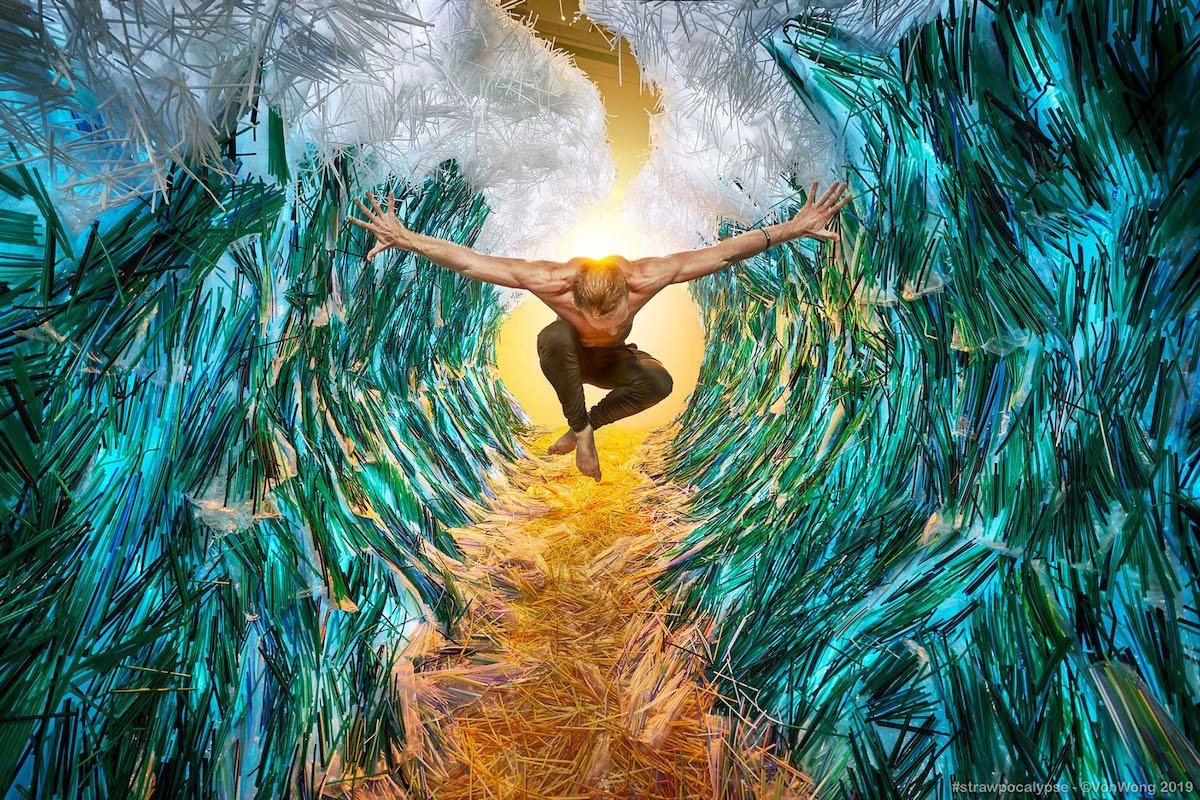
Bringing back up some references from the Social Practice Art reading, this installation cannot exactly be said to constitute a whole social environmental movement, but to some extent I feel that it is, or at least supports an existing effort to be more mindful of our waste production, of our environment.
I feel that the process of making this installation itself reflects thoughtful interaction design. The way they collected used straws instead of using new ones itself is thoughtful. This is not new, of course, making art through recycling or upcycling.
The result of the installation is something impactful, putting humans in a smaller scale, highlighting the magnitude of this environmental issue.
Michelangelo Pistoletto
I remember coming back to ADM after the break and noticing that they did some re-decoration, which shocked me. They seem to have spiced up the classic ADM rooftop with some gardening…
I didn’t think much of it until I found out that we were going to attend a dialogue session with the artist behind the “re-decoration”. I thought, whoa, so that’s an installation? I wondered if it was going to be permanent; I couldn’t decide whether or not I liked it.
After watching the documentary showcased at the Dome, I had a better understanding of Pistoletto as an artist. I could relate to his relationship with his father, and how he discovered his personal way of art-making. There were two works that stood out to me from the film: his mirror paintings and the “Walking Sphere”.
M I R R O R P A I N T I N G S
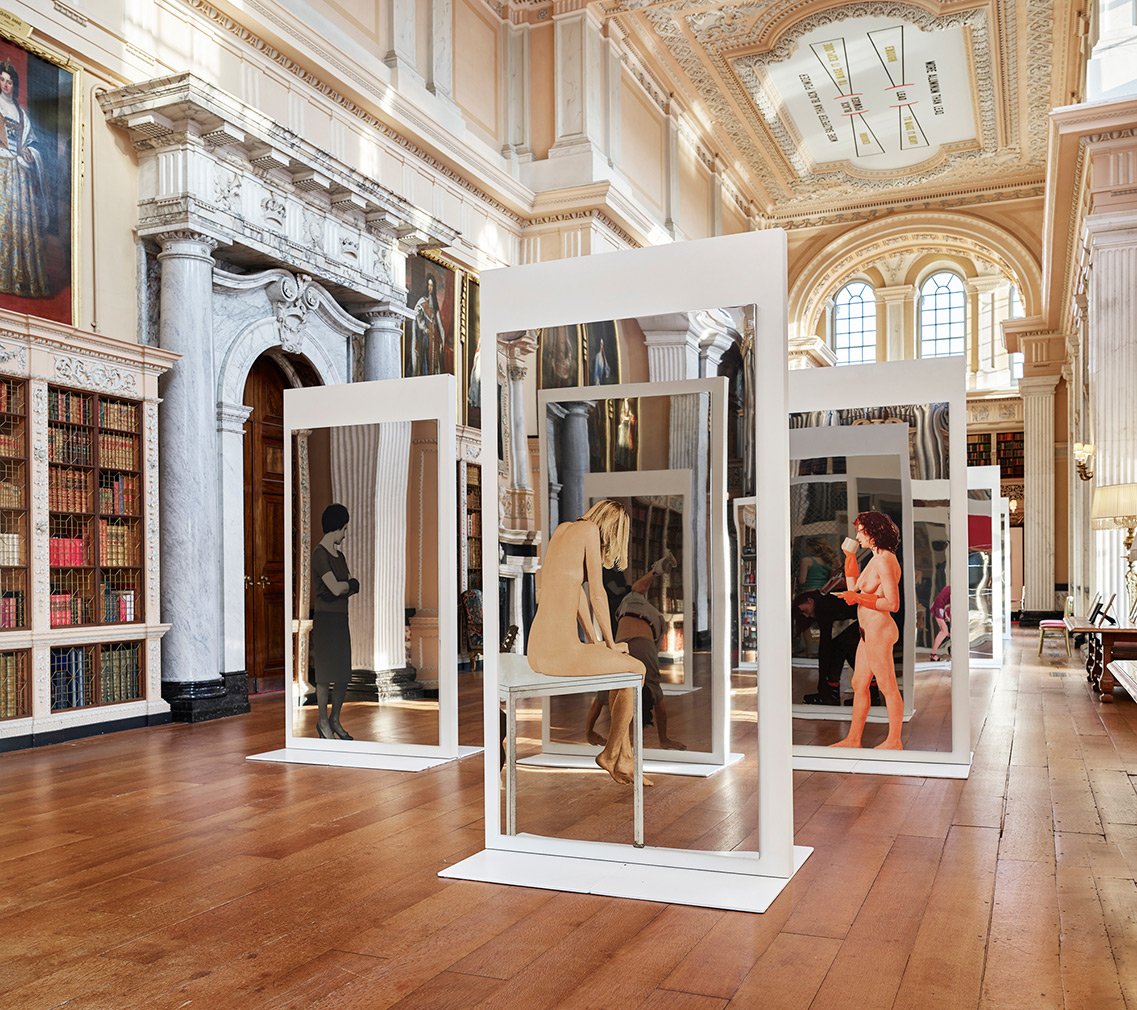
I love how its simplicity can bring about such profound meaning. I myself have painted on mirrors before, but I never thought about it in a way that Pistoletto did. How a simple change of medium could change the meaning of the work, the way the audience would view it, the entire concept I think is just mind blowing.
The mirror itself has a great deal of symbolism. Of self-reflection, truth, and parallel worlds to name a few. By painting common people on the mirrors, Pistoletto manages to capture a moment in time, sometimes of the people off-guard, hence showing their true selves. In a sense, it feels like two separate moments, two separate individuals were brought together in this work.
Imagine if the mirror was displayed in different settings. It would be as if transporting the subject of the painting to different places! Another interesting concept that I interpreted is voyeurism. How the paintings capture these people in moments, and us as an external audience, are brought into the same plane of existence in that same moment.
W A L K I N G S P H E R E
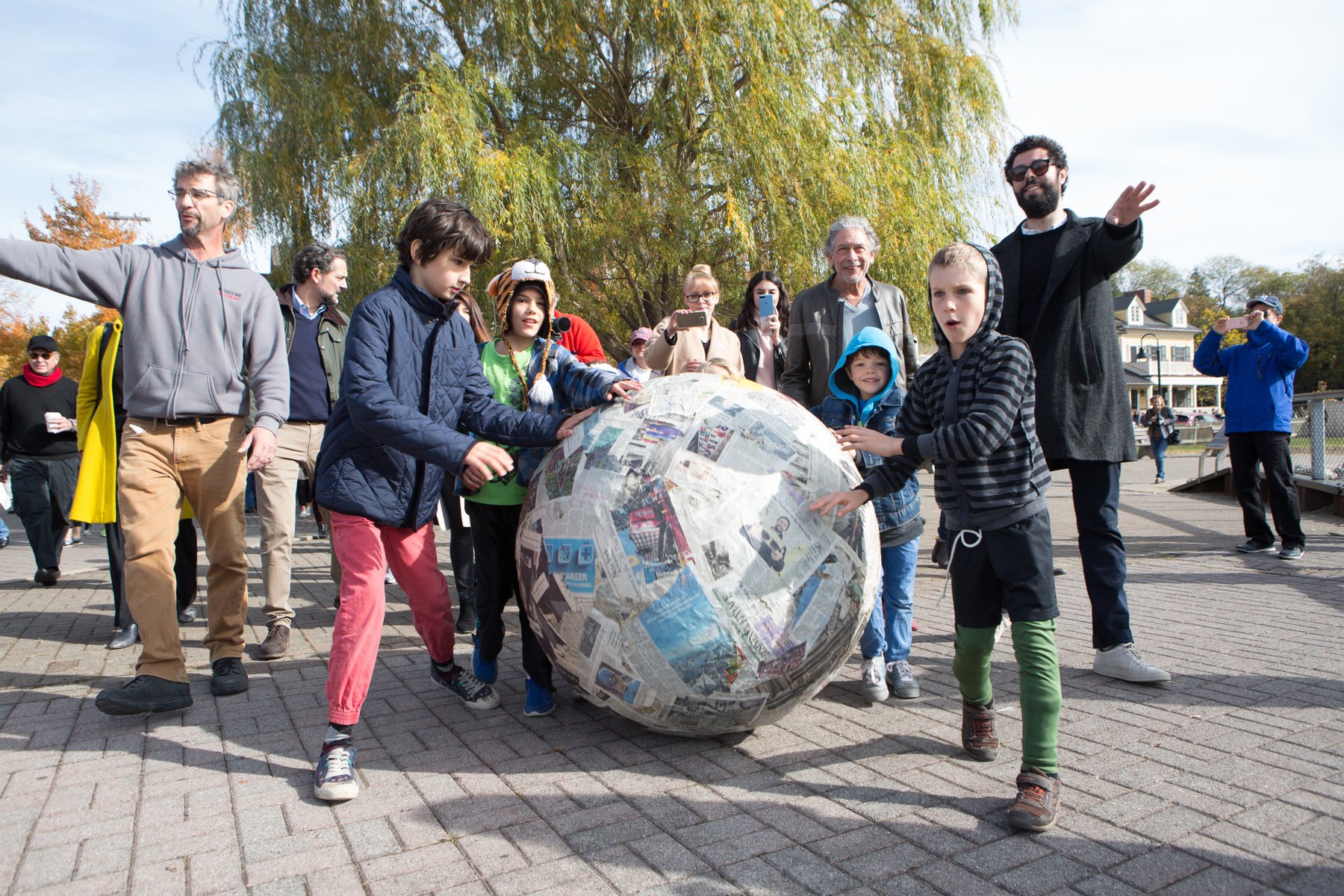
The Walking Sphere is a performance that Pistoletto had started in 1967. Since then, numerous reenactments have been performed in many different places.
“We want to bring art out of the museums into the streets, to people. And to act. The sphere is a point of attraction. It’s a way to bring people together, and to act together”
– Pistoletto during one of the reenactments, in Cold Spring, November 2017
The world of art can sometimes be depicted as or seen as inaccessible, out-there or exclusive. This is enhanced by the reputations of museums. On one hand, I feel that it is important to value art and artists, but on another hand I also feel that art should also be accessible to everyone.
This is what Arte Povera, or art of the poor, is about. It is not poor art, but it is art for everyone. With very simple, cheap, available materials, the Walking Sphere is able to bring people together, creating a moment, an experience. It literally brings the art to the people, anyone and anywhere.
Ultimately, I feel that in this day and age, there is no longer clear boundaries in the art world. You can make art in any way, and value it in any way. Everything depends on the context, the artist, the audience, the message, etc. I think that it’s really cool how as artists we have the freedom to define that for ourselves.
Clarita Saslim
B I O G R A P H Y
Clarita Saslim is a dreamer, thinker, and a lover. She pours her soul into her craft and hopes to be a visionary artist, expressing herself through illustration, interactive devices, installations, and designing experiences.
Born in Jakarta, Clarita currently lives in Singapore, where she is pursuing a Bachelor of Fine Arts, specialising in Interactive Media in Nanyang Technological University’s School of Art, Design and Media.
Influenced by her upbringing in multiple cultures, Clarita also takes inspiration from the world around her. She believes that everything is interconnected and takes interest specifically in human interactions and behaviour. Keeping up with the digital world, she actively explores the possibilities of technology in her art, but also focuses on the physical experience, which is the essence of interaction.
With her interest in theatre, theme parks and circuses, Clarita hopes to further pursue her passion in the performing arts and eventually contribute back to the arts community in Indonesia.
W O R K
MiMOSA, 2018
Lasercut MDF boards, corrugated boards, servo motors, touch sensors, Arduino UNO, PWM driver.
MiMosa is an interactive accessory that was inspired from the eponymous plant. It embodies the instinctive act of self-preservation and explores the notion of human interaction. Mimosa illustrates how people put their guards up when others cross their personal space bubbles. This device focuses on shielding the user’s face, as the face represents a person’s identity and emotions. As the plant closes up its leaves when touched, MiMosa closes up its arms to shield the user when physical contact is made.
R E S U M É
B L I N D L I G H T B Y A N T O N Y G O R M L E Y
Blind Light, 2007
Antony Gormley’s “Blind Light” is an installation in which the audience themselves become part of the work and their consciousness becomes the subject matter. “Blind Light” looks as if a cloud was trapped in a glass room. People are free to wander inside, but they will be blind, though instead of darkness, all they see is white light. Participants will experience being just their consciousness.
What excites me most is the level of audience interaction and participation. As an audience, I would like artworks that involve my participation or that engage me in multiple ways. This made me realise that I would love to be behind the props, moving sets or costumes in theme parks or stage performances, and I am inspired to always think of the audience’s perception when making art.
